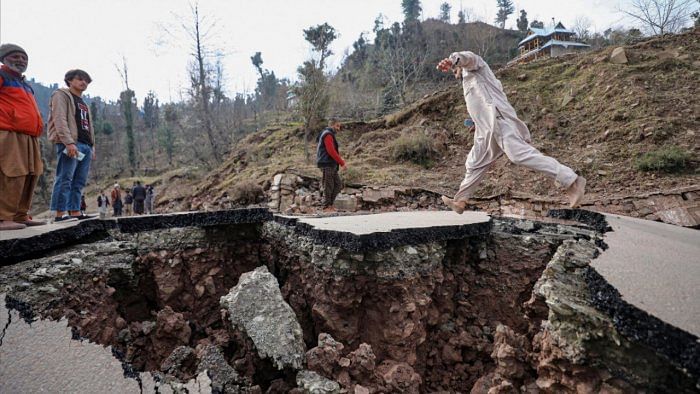
Geological Survey of India (GSI) plans to launch an early warning system for possible landslides across the nation in 2026, an official of the organisation said.
The Kolkata-headquartered scientific body, the nodal agency on landslide hazards, has already started disseminating such warnings on an experimental basis to Darjeeling and Kalimpong districts of West Bengal and Nilgiris in Tamil Nadu, GSI Deputy Director General (Policy Support System - Planning and Monitoring) Asit Saha said.
"GSI is in the process of developing and validating a regional landslide early warning system and efforts are on to make it operational in different states in phases from 2026 onwards," Saha told PTI on Thursday.
It has already carried out a nationwide landslide susceptibility mapping on a 1:50,000 scale for the hilly and mountainous areas of the country prone to landslips. In terms of area it covers about 4.3 lakh sq km, which is 12.6 per cent of the country's landmass and is spread over 19 states and union territories, he said.
India is prone to landslides and according to GSI about 0.42 million square km covering nearly 12.6 per cent of its land area, is prone to landslides.
The mountainous region of the north-western Himalayas (Jammu & Kashmir, Himachal Pradesh, Uttarakhand), the sub-Himalayan terrain of the north-east (Sikkim, West Bengal-Darjeeling, Assam, Arunachal Pradesh, Manipur, Meghalaya, Mizoram, Nagaland, Tripura), the Western Ghat areas (Maharashtra, Goa, Karnataka, Kerala) and the Eastern Ghat areas (Araku area of Andhra Pradesh, Tamil Nadu) are prone to landslides.
"The landslide susceptibility mapping categorises areas where the landslide susceptibility is high. We have prepared the map and identified zones in the Himalayan states, including the northeastern ones, as well as in the Western Ghats region which are prone to this natural calamity. We are now involved in nationwide study on 1:10,000 scale for landslide susceptibility zonation in critically-identified sectors, mostly in the Himalayas," Saha said.
GSI, founded in 1851 and one of the oldest survey organisations in the world, also carries out site-specific detailed landslide mapping on 1:1,000 scale for specific areas affected by such events, he said.
"We have completed such a study at Kinnaur in Himachal Pradesh," he said.
On the landslide warning mechanism, he said, “GSI is establishing the system for rainfall-induced landslides. We have already started disseminating such warnings on an experimental basis in Darjeeling and Kalimpong districts of West Bengal and Nilgiris in Tamil Nadu. "We also carry out specialised investigation on active fault mapping, seismic micro-zonation and neotectonic studies in various selected parts of the country, including the Himalayan region," he said.
The survey organisation has been working with a regional landslide early warning system for which it has collaborated with British Geological Survey. He said geochemical and geophysical mapping are part of GSI's baseline data generation process that helps in identifying areas where mineral exploration can be conducted.
"Geochemical mapping covering the entire country, except Thar desert and Indo-Gangetic Plains will be completed this year and geophysical mapping will take another three to four years," Saha said.
Geophysical mapping deals with physical parameters of the earth such as magnetic and gravity anomalies, while geochemical mapping gives information about the dispersion patterns of different elements on the earth's surface.
Asked about the National Geoscience Data Repository (NGDR) project taken up by GSI under an MoU with BISAG-N, Gandhinagar, Gujarat, Saha said, "The portal is expected to go live by August-September this year".
The programme is aimed at promoting mineral exploration. "Data collected by GSI and other agencies will be put on the portal so that entities which are keen to take up mineral explorations can access the digital repository," he added.